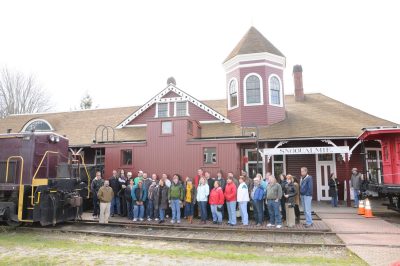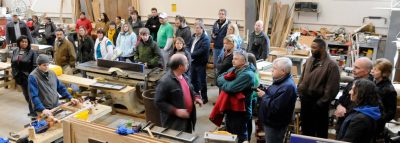 The Northwest Railway Museum recently hosted an historic structure field school. Maintenance and repair of historic structures is a course regularly offered by the Army Corp of Engineers and outlines the unique characteristics of historic structures and the technical knowledge, skills, and procedures used to care for historic properties owned by the Federal Government. The course also addresses the concomitant legal and administrative requirements.
The Northwest Railway Museum recently hosted an historic structure field school. Maintenance and repair of historic structures is a course regularly offered by the Army Corp of Engineers and outlines the unique characteristics of historic structures and the technical knowledge, skills, and procedures used to care for historic properties owned by the Federal Government. The course also addresses the concomitant legal and administrative requirements.
The course was conducted by Horace Foxall, Jr., a nationally-recognized historic preservation expert and a member of the National Advisory Council on Historic Preservation. Mr. Foxall recently retired as the manager of the Army Corps of Engineers’ Center of Expertise for Preservation of Historic Structures and Buildings. Participants from all across the United States toured the Snoqualmie Depot and observed demonstrations in the Conservation and Restoration Center.
 Clark M., Meg G, and Kevin P. led a demonstration of the techniques used to construct accurate replacement window sashes for the chapel car rehabilitation project. They also demonstrated techniques they use to disassemble the chapel car’s three-light clerestory windows for repair and reassembly. Many of the window construction methods are identical to those traditionally applied to older structures including the use of blind tenons.
Clark M., Meg G, and Kevin P. led a demonstration of the techniques used to construct accurate replacement window sashes for the chapel car rehabilitation project. They also demonstrated techniques they use to disassemble the chapel car’s three-light clerestory windows for repair and reassembly. Many of the window construction methods are identical to those traditionally applied to older structures including the use of blind tenons.
Bill H. led a tour and described the techniques used to rehabilitate coach 218, a 1912-built passenger coach used on the Spokane Portland and Seattle Railway. Coach 218 has received a new floor, the car sides have been completely rehabilitated and new cladding has been applied. New carlines were installed and the end platforms are now being restored.
Both objects are built of wood and apply the Secretary of the Interior Standards for the Treatment of Historic Properties, but the reuse of each object will be very different presenting an interesting contrast for session attendees. Coach 218 is destined for regular operation on the Museum’s railroad where it will carry up to 84 passengers on an 11 mile excursion. The chapel car 5 Messenger of Peace is being rehabilitated for exhibit inside the new Train Shed and will not be used to carry passengers. While functionally complete, the chapel car will rarely operate in deference to its significance and its age. The chapel car is a National treasure listed on the National Register of Historic Places and heroic efforts are being made to reuse as much of the original materials as possible including at least half of the exterior cladding.
The preservation field school was an opportunity to showcase the work the Northwest Railway Museum is doing to preserve Northwest railroad history. This event and others like it help raise awareness in the historic preservation community about the Museum’s activities and share the skills and techniques being developed – or resurrected – to rehabilitate railway history of the region.

